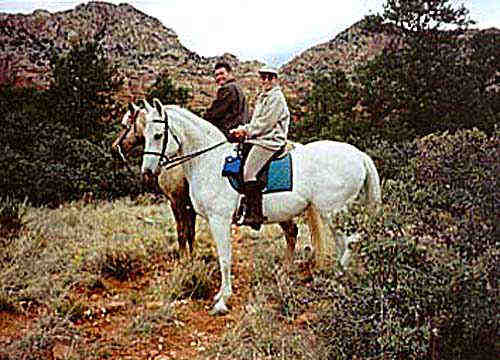
Inty's Story

Yvonne Welz on Inty, riding with her husband, James, in Sedona, AZ,
back in happier days before Inty foundered.
| Gretchen Fathauer's introductory remarks:
Inty did not founder for no apparent reason, as Yvonne states in her story. Long-term high heels predisposed her to laminitis. So did long-term shoeing in heartbars, which restricts hoof mechanism and circulation even more than regular keg shoes. Incompetent vets and farriers made the situation much worse. For instance, the farrier was hoping to get the more normal foot to match the club-footed foot, which is mind-boggling. The "specialist vet" called in who specialized in the treatment of laminitis made one mistake after another--advocating leaving on shoes for 3 months, an ill-advised grooving that turned out horribly, etc. One wonders where this "vet" graduated from! I also am happy that they are now treating the whole horse--body and spirit--by no longer stalling her, but instead turning her out with other horses 24/7. Horses are intensely social animals; being confined alone in a stall must be torture for such socially needy creatures. It is even harder on them to be without the comfort of being with their friends, when they are sick. I wish more people would not just treat the body and ignor the horse's morale in treating laminitis. They are not like cars that you can just park in the garage, make mechanical repairs on, etc. They have emotional needs as well. We both regret she did not find my site at the very beginning! The case could have been resolved much faster and with less trauma, not to mention much less expense, using the information on this site. This is quite a story! Fasten your seatbelts for a bumpy ride! I can only marvel at Yvonne's dedication and courage to weather this experience with her valiant little mare, who was finally getting better again. Eventually, though, she was put down. |
The Story of Inty, by Yvonne M. Welz
My world came crashing down on May 24th, 1999. My beloved half-Lipizzan, half-Arabian mare, Interlude Vedera (Inty) was stricken with severe laminitis and subsequently foundered.
You see, Inty was a horse that dreams are made of. The first time I ever saw her, she was doing a magnificent passage around a paddock. She was 7 years old and unbroke, but I bought her without a second thought.
I trained her myself, from scratch, with just the help of some good books and a few lessons. We competed successfully through second level dressage. There was always something special about her, and despite her small stature of 14.2 hands, she scored really big - actually earning scores of "9" on three separate occasions. A German-educated dressage professional once told me that she had "world class gaits" and could be competitive on a national level.
But competition was just an amusement to me, and I sought something more substantial. This led me to French classical dressage, and after clinics with a master of this discipline, I actually taught Inty to piaffe, Spanish walk, and do flying lead changes. Her high level of training made her such a fun horse to ride, whether it was climbing the rocky trails of Sedona, Arizona, or galloping around the track area at the stables.
Laminitis Without Cause?
There was nothing that led up to the laminitis. It literally came out of the blue, overnight, with no cause, no reason, and no mercy. Knowing what I know now, I see that we were headed for disaster all along. After all, for the entire 8 years that I had owned her, she had been living in a stall, body-clipped, blanketed, and shod in a various assortment of therapeutic bar shoes in a effort to help her "poor-quality" feet.
Monday, May 24th, she showed a moderate lameness in her right front foot. My farrier was there, and he thought there might be a corn under her shoe, as she was due for re-setting. He pulled the shoes, was unable to find a problem, and set her in heartbars, as she had worn them in the past for "therapeutic" reasons. (As a side note, the right front foot had always been a club foot, and the left foot had a low under-run heel. Farriers had always worried about the lack of heel on her left foot, and considered the right foot to be correct. They even added pads to raise the left heel.)
When her lameness was the same the next day, I called the veterinarian. I must stress that the possibility of laminitis was the furthest thing from my mind! I had no idea that such a thing could happen without an obvious cause. Inty was a bit overweight at the time, and had been diagnosed 5 years earlier as "hypothyroid" (although that is a hot debate in the vet community right now), so that is all we had to blame it on.
Here is my chronicle of the events that ensued:
5-26-99 My primary Vet X-rays and diagnoses laminitis. There is no rotation in this initial set of X-rays. Digital pulse is high in right foot and she shifts constantly between both front feet. Start on oral bute 1 gram morning, 1 gram evening; 5 days of Ace injections; and DMSO gel applied to coronary bands. Total stall rest on deeply bedded shavings is prescribed.
6-8-99 Flare-up of laminitis. She begins shifting feet again and doesn’t want to move. Increase bute to 2 grams twice a day for a few days and she is better.
6-19-99 Suddenly severely sore in left front foot. Will not move at all, refuses to lift right front foot off the ground. Increase bute to 2 grams twice a day for a one week and she is better.
6-29-99 Primary Vet takes 2nd X-rays. Severe rotation (8 degrees) in right foot, minor changes in left.
6-30-99 Hoof Specialist Vet is called in to evaluate X-rays, and she determines that we should leave her untouched for 30 days (no changes in shoeing at all, shoes left on as is, with no trim or reset) and X-ray then. She says the heartbar shoes are in exactly the correct spot to serve their purpose (stabilization of the coffin bone). We are to continue total stall rest.
7-11-99 After appearing stabilized for 2 weeks, she begins to favor the left foot. This worsens every day.
7-14-99 Primary Vet looks at her left foot. He pulls out a rusty nail on the inside back and thought it looked like there may be a bruise in that area. We put a Easyboot over that hoof and shoe. She seems to stabilize with only some favoring in the left foot, so we begin to try and decrease the bute. Go down to aspirin in am, 1/2 gram bute in pm.
7-27-99 Primary Vet takes 3rd set of X-rays. She is suddenly very bad in left front foot again. Will not put weight on that foot. There is a whole flap of loose sole falling off her left hoof and Vet pulls it off.
There is also what looks like an abscess draining on her coronary band of the left hoof. Her entire sole is soft and something is severely wrong in that foot. Vet pares into the sole a little bit to see what is going on, and seems to realize he has done too much. Put Easyboot back on. The developed X-rays reveal 8 degrees rotation in left hoof now, with almost no sole under the coffin bone. The right hoof was about the same as last X-rays.
7-28-99 She is much worse today, and lays down for the first time. She cannot weight her left foot at all and spends most of the day down. She seems to be in severe constant pain. We increase her bute to 2 grams twice a day. The bottom of the sole has now opened up about 1/4 inch in the area where the vet had pared it.
7-30-99 Hoof Specialist Vet and two consulting farriers meet with us. Inty is really bad, laying down a lot, and holding the left foot off the ground entirely. Her entire lower left leg is beginning to swell. Specialist Vet tells the farriers that we will not be removing her shoes at all, so they didn’t need to be there.
She explains that the hoof is collapsing inwards under the coronary band and must be opened up in that location or she will burst through the sole (sole penetration). She says that any changes to the angle of her feet by trimming or removing her shoes may cause sole penetration.
The general premise seems to be that sole penetration is the worst thing that could possibly happen (I now know this to be untrue) and that preventing this was our immediate goal.
She then proceeds to use a Dremel tool to remove the hoof wall of her left forefoot, just barely under the coronary band, in a horizontal line that is parallel to the coronary band, about 5 inches long and 3/4 inch high, extending from the front of the hoof to the inside rear of the hoof. She calls this a "coronary grooving." Underneath is raw, pink tissue. She says that the whole open area will harden up in 3 weeks and until then we are to put betadine on the tissues, wrap the entire hoof with Vetwrap (changed every 2 days), and put her on antibiotics. Continued stall rest is prescribed.
The Coronary Grooving
Inty is supposed to improve because of this procedure of "coronary grooving." I was in such a desperate state at the time, I would probably have let someone cut off her ear if they told me that would make her better! I was trusting the "experts," and I allowed this mutilation to take place.
I still do not understand the reasoning behind such a drastic measure. How can inflaming and irritating the hoof tissues and exposing the laminae to the open elements create healing of the laminitis? If I had known the whole story behind grooving and resections, and how this would create months of pain and delayed healing, I would never have considered such a thing.
8-1-99 Inty seems even worse. She is laying down groaning. The 4 grams of bute a day don’t even seem to be working.
8-4-99 Inty is a bit better and begins to put some weight on left foot.
8-5-99 Inty is much worse, and now her right foot is sore. She begins laying down again. Also, tissue (laminae?) begins protruding from the opening on the bottom of her sole. It looks like a little finger sticking out.
8-6-99 Specialist Vet checks her out, and advises one short hand-walk down the barn aisle every day. She also recommends massage therapy.
A Downward Spiral
For the next week, she does not progress. Rather, she is a bit better, then much worse, over and over again. Things get so bleak, Inty is suffering so constantly, that I begin to consider euthanasia. I am almost in constant tears and completely torn apart inside. The vets have no answers for me, it is just "wait and see". I think they were becoming doubtful as to her fate. Certainly at this point, it was only a salvage case. She would never be rideable again.
8-12-99 Massage therapist comes out and works on her. It really seems to make her feel better. But her left foot is bulging more on the bottom and her leg is swelling up again. Also, the tissue is still sticking out on her sole and doesn’t seem to be improving. At my request, Primary Vet comes out and looks at her. He puts her back on antibiotics and provides Panalog ointment to apply to the tissue on the sole. The Specialist Vet's plan is to continue treatment with the heartbar shoes as soon as she could be re-shod, but so far she has been in the same shoes for nearly 3 months!
8-17-99 She continues on about the same, which isn’t real good. There seems to be no end to her suffering. I can only admire her will to live.
A Glimmer of Hope
Out of sheer frustration, I had spent the past couple of months searching the internet for anything with the keyword "laminitis" in it. Most of the information was just downright depressing, but I found a very intriguing site that kept drawing me back to it. The site is titled "Treating Founder (Chronic Laminitis) Without Shoes" http://members.screenz.com/gretchenfathauer and is written by Gretchen Fathauer. Within this extremely detailed and photo-filled site, she describes her experiences with her foundered horse, Max, and her discovery of a treatment method that can actually heal the foundered horse's feet. Her web site is a wealth of information, and I studied it avidly. On this web site, I also discovered a link to order Dr. Hiltrud Strasser's and Jaime Jackson's books, who are the originators of this treatment method.
The premise of this method was surprisingly simple. Remove the horse's shoes, trim the feet in a special way that simulated the natural wear of a wild horse, turn the horse into a pasture to live, hand-walk or exercise the horse as much as possible, and provide daily hoof soaks in water. In essence, return the horse to a more natural state, to allow his hooves to heal the way nature intended--a truly holistic approach to healing this horrible affliction of our modern horses.
I finally received Dr. Strasser?s book "A Lifetime of Soundness," and Jaime Jackson’s books, "The Natural Horse" and "The Horse Owner’s Guide to Natural Hoofcare," and read these books from cover to cover, immediately. They literally changed my life, overnight. Suddenly there was a glimmer of hope! Maybe we could save Inty. Was there really a miracle cure? Would such a simple, natural treatment method succeed where standard veterinary medicine had failed?
But then began my conflict. This would go against everything that the professionals were telling me to do. This would alienate me from my vets, my farriers, even my friends! I would have to completely change my entire equestrian life, and abandon all the practices that I had spent so many years defining. Would I have the courage to proceed with this enormous task at hand?
For the love of a little grey mare, of course I would.
But I couldn?t do it alone. I needed something and/or someone to validate what I was doing. I began e-mailing Gretchen Fathauer, author of the web site, "Treating Founder (Chronic Laminitis) without Horseshoes," and she gave me so many leads and tips to get started! With Gretchen's help, I began talking on the internet to people all over the country having similar experiences. She pointed me in the right direction and literally gave me the courage to begin. She referred me to Frank Orza, the inventor of the Horsneaker hoof boot and proponent of the natural hoofcare movement. Since he also lived in Arizona, she thought he might be able to assist me in some way.
8-18-99 Talk to Frank Orza (inventor of Horsneakers) and his wife, Mary, from Tombstone, Arizona. After hearing my story, they offer to drive to Phoenix the following Sunday and pull Inty?s shoes and teach us how to trim.
8-19-99 Move Inty into a 1-1/2 acre pasture, along with my other horse. Overnight she changes from a depressed, moping creature that was lying down most of the day, into a much happier horse that now looks like she will survive.
I also attempt to discuss these new methods with the Specialist Vet, but she is not cooperative and basically tells me that I am on my own. She doesn’t return my last couple of phone calls.
8-22-99 Frank Orza and his wife, Mary, come to counsel me and remove Inty’s shoes, which had been on, untrimmed, for 3 months now. Frank had to use a hacksaw to remove her right front shoe, as she can’t lift that foreleg at all! We get the shoes off and Frank gives my husband, James, instructions on how to rasp her feet every day to try to get the heels down and the toes shortened. Her hooves are so very long now, with dangerously high heels!
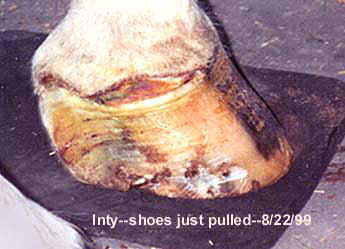
When we removed the bandage, the infection underneath had a horrible smell. The entire coronary area was grossly swollen with raw flesh. They recommended I use only a very light cotton wrap over the grooved area to keep the flies away, and that I wash it with peroxide and betadine wash every day and cover it with aloe vera cream. They had planned to loan me a pair of Horsneakers, but the grooved area would be rubbed by them, so we decided to wait several months before attempting to make some for her.
Today is her very last dosage of bute. She had been taking bute every day for the past 3 months.
Over the next week, she continues to get a little better every day, for the first time. Every day I walk her around the pasture and twice a day her open areas are washed. The swelling goes way down in the area of the coronary band over the grooving. The pus stops coming out of the grooving area. The sole of her left fore begins to flatten out. The opening begins to seal up a bit and the tissue no longer protrudes as much, and is less sensitive and harder. She is off all painkillers, and is uncomfortable, but okay. She lays down some every day, but is up and walking slowly around most of the time. We continue her antibiotics till they run out on 8-29-99.
8-28-99 We are able to lift her right hoof for the first time in over a month! Three times we get her right hoof up for 5 minutes apiece, and James goes to work as fast as he can on her heel. Over the next couple of days, we are able to get her feet trimmed a lot more.
The Strasser Method
Although we have made some progress, I do realize that we need more help. I decide to contact Sabine Kells for the photo consultation that Gretchen had told me about. This involves mailing photos of your horse’s feet to Sabine, and she then critiques your trimming and gives advice on how to implement the Strasser method of rehabilitation.
8-30-99 Call Sabine Kells in Canada for a photo consultation. She is very receptive, and we talk at great length about Inty and what has happened to her. She is very concerned about this "grooving". We agree that I will mail photos ASAP.
8-31-99 Begin soaking Inty’s left forefoot in apple cider vinegar water, per Sabine’s instructions. Try leaving the bandage off, with some Swat fly ointment above and below the grooving area (but not touching it).
9-2-99 After lending him a copy of Dr. Strasser's book to read, I finally muster up the courage to talk to my Primary Vet about the direction I have now taken. Even though he is skeptical, he tells me that if this helps my horse, he is happy that I made this decision.
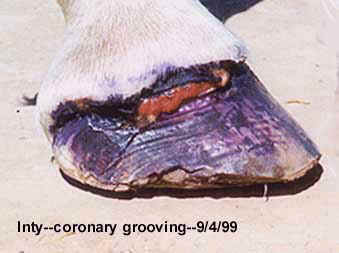
9-7-99 Mail package to Sabine. This includes not only complete photos of Inty’s hooves with our attempt at trimming, but also the videotape that I had been making of her since the day her shoes were pulled.
Our Attempts at the Trim
For the first 2 weeks after our crude attempts at the trim, there appeared to be no real progress. She seemed to get more uncomfortable after each trim. The grooving area became slightly more swollen, and turned from red to white, but stayed soft and moist.
The third week after our attempts at the trim, there was significant progress in her comfort level. After a trim which ended up taking a lot of heel off the left front foot, she began to put more weight on the left front and to walk better, more willingly and more evenly. On 9-22 she willingly lifted up her right front foot for the first time in months. The grooving area also began to scab over.
At this point, the condition of the left and right hooves was worrisome. The left front grooving area showed little to no growth above the swollen, inflamed coronary band. There was a wrinkle in her hoof wall that continued past the grooving area on both sides, that looked as though the hoof wall was buckling or collapsing. This ended about midpoint on the front of her hoof, then the outside of the hoof did not look too bad. The sole of the left front was bulging, and the bulge was uneven, with most of the bulge on the inside of the hoof, so that it appeared the coffin bone was twisted. She was actually standing on the coffin bone bulge, with no weight on the hoof walls, which had shrunk up or broken off since her shoes were removed. The opening on the toe sole closed over and hardened, but then cracks appeared right next to it, closer to the front of the toe, right behind the white line.
The right foot was showing a dip of horn all around the front below the coronary band. It had some questionable-looking spots on the sole, and had probably been abscessing too, but I was unable to soak it in a bucket of vinegar water as she would not lift the that foot.
The two hind feet, although not originally diagnosed as having laminitis, both began showing signs that they too had suffered. The right hind seemed especially painful, as she totally refused to lift the left hind foot at all. Both seemed to have an odd shape, and seemed uncomfortable when she walked.
9-22-99 Sabine receives the package and calls me, very distressed about what she sees going on with Inty’s feet. She says this is a very bad, very serious case, and really is a "clinic" situation. She says that the "grooving" that had been done to her left front hoof will significantly delay her healing and lengthen the time needed for a full recovery. We would be looking at possibly 2-3 years for total recovery, though she may be sound in one year. She says it will be hard, next to impossible, to convey what we need to do without first-hand experience. Because of the seriousness of Inty’s feet, and how crucial the trim will be to her recovery, Sabine convinces me to send my husband to Canada to train with her for a couple days. We decided for James to train first because he had already been working on trimming, is more physically talented than I am, and learns skills very quickly.
9-24-99 An area of flaky hoof above the grooving area falls off completely, and tissues turn bright red with some blood on them. This had hardened up and shrunk a bit, with real improvement the last few days. We can actually see the hoof wall below this area (was hidden by swelling), and there is a lot of growth above the grooving on the left and right side, with a small amount of growth in the center (but it is there).
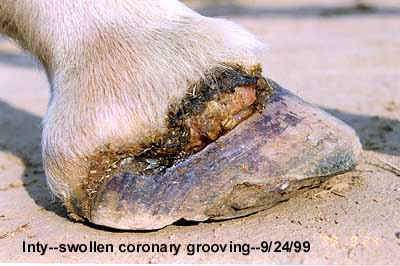
9-25-99 I was able to pick up all 4 feet for the first time. I also walked her on some hard ground, and she did very well.
9-24-99 through 9-27-99 James flies to Vancouver Island, British Columbia, to train with Sabine Kells. When he returns, he tells me it was worth every penny. He learned so much while he was there. Even though we had previously studied the books and tried so hard to do a correct trim, he said that we didn’t even have a clue what we were doing! Without hands-on experience, it is next to impossible to trim the hoof in such a seemingly drastic way!
Even though his training was short, Sabine had given James the tools he needed to get started. Not only mental tools, but also German hoof knives, the only kind that can be made sharp enough for a Strasser trim.
9-28-99 James trims Inty’s left front foot (the bad foot). It is simply amazing—when he is done, she literally has a brand new hoof. I am in shock at how much hoof he was able to remove.
Over the next several days, he slowly finishes the first round of the trim on all her feet. This trim is very time-consuming, especially for the beginner, and very meticulous in its details. And it is almost never-ending (there is always something else to work on) which is why they recommend trimming at least twice a week. Most of the trims simply involve refining your last trim.
The daily ritual of Inty’s care since we began the Strasser method is quite simple. She is kept in a large, dry-lot "pasture" with a herd of other horses. She is fed free-choice grass hay, some alfalfa hay, and oats. She is hand-walked twice a day (using a whip when necessary to force her to walk) for at least 20 minutes at a time. All four feet are soaked daily in water or mud for 20 minutes, and her left forefoot and any abscessing feet are soaked in a bucket of water mixed with apple cider vinegar.
Upon Sabine’s advice, I have discontinued all feed supplements. This included Farrier’s Formula, MSM and Thyro-L Thyroid medicine (the Thyro-L was discontinued very slowly). Given natural living conditions, Sabine feels all these things are unnecessary. The only supplements should be free-choice minerals and salt.
The Abscessing Phase (from Bad to Worse?)
Right after the trim, expect the abscessing phase to begin. The trim sets into motion and accelerates the healing processes, and this involves the excrement of all the dead tissue inside the foundered hoof. There is simply no other way for the body to get rid of this necrotic hoof tissue, so abscesses can form in the hoof capsule, the coronary band, the sole, even the pastern. This is probably the hardest period to get through! You know you are on the path to recovery, yet your horse seems worse. At this point, you really need some Strasser support people to hold your hand.
After the full trims, she was more sore and would not pick up all feet. After a couple of days, she began to walk a little better and improve.
10-2-99 She laid down while we were there. As she was flat out, I decided to try sitting on her neck to keep her down, so we could completely finish up her trim. I followed the instructions my vet had given me, and sat close to her head, holding her nose towards me with the halter. She lifted me straight up off the ground!! Unfortunately she may have strained herself while doing this, as she now she is very sore and her whole left leg is swollen (she was laying on her left side). I feel terrible! (I later find out that all her pain and swelling had less to do with a strain, and much more to do with the abscesses stirring up inside her hoof.)
10-3 and 10-4-99 She can hardly walk. She is more sore than ever, and her whole tendon is swollen down her left leg. She walks even more stiffly, without bending at the knee, and to get her started I have to whip her with the end of the lead rope. Her feet are doing very well, though! Just a temporary set-back. Unfortunately, this soreness is making her lay down even more frequently.
I am also worried about her weight (she had lost a lot of weight). Her ribs are really beginning to show a lot, and I don’t want her to lose any more weight.
10-5-99 More swelling of lower left front leg, mostly on inside tendon area. She is more sore, laying down most of the day. Very difficult to get to walk. James touches up trim, but still can’t get the left hind, as when she lays down, she is on wrong side.
10-6-99 Even more swelling, even more sore. She is holding the left front off the ground, and won’t put weight on it while standing. She is laying down when I get there, so I am able to rasp some heel off left hind.
10-7-99 Entire lower leg is swollen, like huge stocking-up. She is more sore, shifting constantly to the rear end. James finally trims her left hind while she lays down, though he is not able to get it exactly right, because her position lying down makes it difficult.
Something very strange has happened to her left front hoof - the front 1/3 including the point of the frog has disappeared and/or turned into sole! James trims some away, but there does not seem to be frog there. I take photos of it. Also, there is a lot of growth going on, though the hoof above the grooving still looks odd and flaky. Sabine tells me she has seen another case where the frog turned into sole material.
10-8-99 Receive Propolis Tincture from Sabine and begin applying it to her open area (grooving) on left front hoof. The grooving area had not healed up after 2-1/2 months of being an open, oozing wound. It wasn't until I began applying the Propolis that it finally healed.
Unexpectedly, my Primary Vet is out at the stables, and wants to see how Inty is doing. I tell him about what happened when I sat on her neck. He agrees she may have strained something. He looks at her and says her weight is okay right now, not to worry. He looks at her feet and is really impressed with them. He says he looks forward to watching her recovery. He asked how long Sabine said it will take her to recover. I will get together Sabine’s papers and show him exactly what we have been doing. He is very interested in this.
10-9-99 When I arrive, her left front leg is even more swollen! I begin to walk her, and when I look down I see her coronary band on the outside of the hoof looks funny. I touch it, and it bursts open, bleeding - an abscess must have just burst open. We continue walking, and she improves, and the abscess continues to drain. I soak the foot for a couple hours, and note how much more comfortable she appears to be, finally putting weight on the left front, and able to stand without so much shifting to the rear.
10-10-99 Swelling is down a little bit in the leg. She still does not want to walk, and she walks very slowly today. I wonder how many more abscesses may be in there. She is doing okay, at least better than she had been, putting weight on the left front. She is still laying down a lot, easy to tell from the bed sores on her elbows and hips.
10-11-99 Abscess is still draining blood when we walk. She seems to be walking a little better.
10-12-99 Swelling down a little in left foreleg, walking very slowly, but she is up when we visit her morning and night. (Has been laying down for past few days whenever we arrive.) Do not notice any draining on hoof today.
10-13-99 Abscess begins draining again on outside coronary band. The draining is very blood-colored. She is walking very slowly (takes forever to get around pasture!), but she is up when we arrive again.
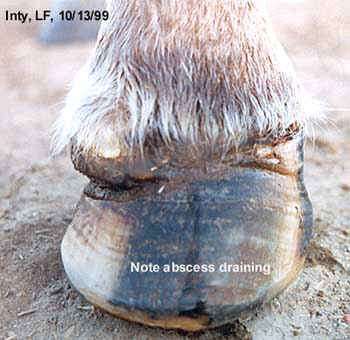
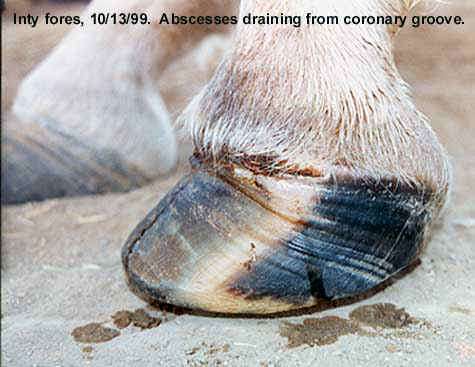
10-14-99 James trims left front in morning, and when he does, he pops open a large abscess in the outside heel area of left front foot. The results are immediate - after he is finished, she walks better than she has all week. Swelling in left foreleg tendon area is also completely gone today.
10-15-99 Seems to be walking a bit slower again. No swelling in leg at all. There is now an abscess draining on the front of the coronary band on the left front. James works on left foot trim again in the evening.
10-16-99 Inty seems fair, walking very slow again.
10-17-99 James does a full trim on all four feet. She seems about the same, although we are worried about the cracks that are appearing in toe area of left front sole. They seem to be ahead of the coffin bone. The whole toe area now seems very soft (inflammation horn?) We are also concerned about the apparent shrinking in of the hoof around the front toe wall at the coronary band, as well as the cracks in the coronary band/wall juncture where the abscesses are draining. She is also swelling in the whole pastern area now, and the coronary band around the grooving is more swollen. The abscesses are all draining a bloody serum, outside and front coronary band, and sole heel.
10-18-99 Inty seems about the same, except her left front pastern, and now tendon area too, are more swollen than yesterday, but she is walking a little better. We manage to walk at least 5 times around the pasture. Abscesses are still draining--the more we walk, the more they drain.
I talk to my vet extensively about the Strasser method. He tells me this goes against everything he has ever been taught. I tell him that in a year, Inty will be trotting around the pasture. He said that if she is trotting around the pasture in a year, he will be a total believer
James is still worried about Inty losing the left front hoof capsule. The attachment is probably very weak, since the grooving side is destroyed, and now the abscesses are encircling her good outside areas. The only truly intact area is the outside heel. Hopefully it will hang on. Also, there is still no true growth in the center of the grooving area. The sides are coming in, but about 1" wide in the center, there is nothing. Frog is still mutated into sole about halfway down. James thinks entire foot may be shifting position backwards to realign with coffin bone.
Week of 10-19-99 Inty continued to be sore and swollen in her left front leg. Her sole looked very bruised. Leg swelling begins to taper off. She continues to drain abscesses on her coronet band and sole, both heel and toe area. By the end of the week, she is suddenly walking significantly better.
Week of 10-25-99 She begins walking worse again. However, I am told by stable owners that she is standing up for the longest time they have ever seen. The grooving is finally healing and growing. James says that every time he trims, her hoof is completely changed. It appears to be totally remodeling itself, and moving its entire position backwards.
Week of 11-1-99 She really is starting to seem much better. There is a sparkle in her eye that wasn’t there before. James has been trimming every weekend.
Week of 11-8-99 She starts abscessing in her right front foot, the toe area. She allows me to begin soaking the right front in a bucket. She walks more evenly now because her right foot is hurting too! Her left foot does seem to be feeling a lot better. The swelling is almost completely gone in the coronary area, and there is good hoof growing in, very slowly.
Progress at Last!
Week of 11-15-99 Inty is definitely moving around more and laying down less.
She is really improving. She keeps walking better and better. James does major trimming on her hooves on 11/13, 11/20 and 11/21 (spending at least 12 hours total!), and with the help of a new cordless Dremel, prepares them for the photos for Sabine taken on 11/21. Inty is of course very sore after the trim, but is still walking fairly well, with a little encouragement.
The photos show a greatly improved left front hoof. It is finally growing out! The grooved area is completely healed over and hardened. (The grooved area was supposed to heal over in 3 weeks; instead this took over 3 months!) The growth of her hooves continues to accelerate.
Week of 11-22-99 Continued slow, but steady improvement. And continued hoof changes! Another abscess breaks open on the right toe. The left hoof, although seeming more comfortable, cracks along the entire sole area and across the side, like a big chunk is ready to flake off! Constant changes seem to be the norm. Every day the hoof looks different, so I just don’t worry too much about it anymore
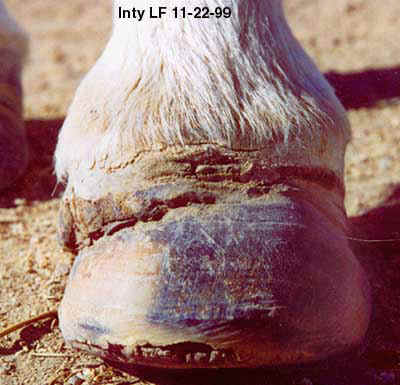
When I consider the major structural changes that have taken place in Inty's hooves during this healing process, I cannot help but wonder how on earth this could have taken place if she had continued to wear shoes. It is obvious that it could not have happened! Herein lies the key to the entire problem. Shoes prevent the changes necessary for healing. A shod laminitic horse will never make a full recovery.
Week of 11-29-99 She keeps getting just a little better every day, walking better, feeling better. We are headed in the right direction. A major breakthrough when I am able to walk her across the gravel road to reach the stables’ 1/2 mile track. I hand walk her around the track in a nice 4-beat normal looking walk. She almost looks sound!
During the past few months, we have been:
- Soaking her feet daily in the Davis soaking boots for 1-2 hours, or in mud for 15-20 minutes.
- Walking her daily on mostly soft ground, and just a little hard ground for about 1/2 hour twice a day. She is noticeably better on soft ground and worse on hard ground.
- Trimming her hooves weekly under the guidance of Sabine Kells.
- Providing free-choice mineral supplements, free-choice Bermuda grass hay, a limited amount of alfalfa, and 4 lbs of whole oats daily. All other supplements were discontinued, including Thyroid medicine and Farrier's Formula.
Week of 11/29: The left front toe cracks right open, and looks weird, but doesn?t seem to bother her at all. Later in the week, her right lower leg begins to swell, just like the left one had months ago. Finally, an abscess appears on the coronary band of the right front. She is definitely sore on the right foot now, and when I walk her around the track again, she limps a bit on the right foot, then smooths out.
Week of 12/6: The right foot continues to cause her discomfort, then it finally breaks open and drains a bloody serum at the coronary band. This creates relief, and she improves again. The swelling goes away. By the weekend she is looking and acting much more chipper. The stable owners tell me they rarely see her laying down, and she is often mingling with the other horses. James does a major trim on 12/11, and expects her to be more sore. Instead, that night we find her on the other side of the pasture! She is moving around a lot more. Things are looking good.
12/14/99 - 1/10/00: Mostly uphill (albeit slowly). There have been times that I have hand-walked her on soft ground and she almost looks sound! Her feet have continued their transformations, and the sole is opening up a bit on both feet in the area where the slipper begins. Week of 1/3, she began to walk and move around much better, but then on 1/6 she began to develop a severe abscess in the heel area of the right front. She is currently extremely sore and very lame on that foot. Her entire lower leg is once again swollen. She is not unwilling to walk, thankfully, but she is laying down much more.
Week of 1/10: Bad abscess in right front continues. Begin filing off the "bootie." This does take a while! Her feet are very dry.
Week of 1/17: She seems better. People tell me they see her standing up all the time now. On 1/23 Shayla (our other horse, and Inty's lifelong only buddy) dies, and Inty is alone in her paddock (though surrounded by horses on all sides). She seems depressed for several days.
Week of 1/24: Receive the Davis boots and begin soaking in them. I am told that she was seen kicking up both her hind heels in a giant kick at a nearby horse! That?s my normal Inty.
Week of 1/31: Frog begins peeling up on right front. Left front has giant hole or cavity in the toe sole area. Major trim this weekend seems to stir things up again, and she becomes more sore.
Week of 2/7: The first day after the trim, she is walking better than ever. The next day, she is walking very sore again. Changes are going on again. The grooving area is near the bottom of the hoof now, grown out on the hee, but only about halfway down the toe. I believe this area may still be causing some pinching.
Week of 2/14: Midweek she is walking a little worse, but by the weekend, she is walking better than she ever has. I even walk her around the stables barefoot over rocky ground, and she is not too uncomfortable. She is really good on the soft ground. She is also perkier and filling out well, and is playing with nearby horses a little bit.
Week of 2/21: By the end of the week, she is developing an abscess in her left front. It drains some while walking on Saturday and Sunday. James does a major trim on it Sunday, and she becomes extremely sore. The entire front portion, which is the grooved section, is close to the ground and growing loose. This seems very uncomfortable for her. James is trying to remove as much as possible.
Week of 2/28: We seem to enter a slump because she stays pretty much the same for a while.
Week of 3/6: One good thing, we get rain! In fact, a giant flood. The stable owners want to move her to a stall so she won?t have to stand in the water! Of course I tell them no way!
Week of 3/13: She seems to be doing better, walking pretty good on soft ground.
Week of 3/20: She is doing really good, and I even trot her in hand a couple of times on soft ground. She is willing to do it! She is pretty gimpy, though. A big change on 3/26, our new Palomino yearling filly moves into the paddock with her. Inty doesn?t seem to like her at all! This changes after a couple of weeks, and now they are loving.
Week of 3/27: Big giant abscess hits her left front. She is really sore, then it starts streaming blood from that opening below the coronet band on the front of the hoof. It's at least a week before she improves. James does major trimming on the left front on 4/2.
Week of 4/3: She seems a bit better. As soon as she can handle it, James does major trimming on her right front and right hind on 4/4. Then on 4/8 we finish up with the left hind (he needs my help for this one). He tried very hard to take enough hoof off, and seemed to go a bit too far! But it will grow. For a couple days, she is very tender. When I get back the photos of her freshly trimmed hooves, I am amazed to realize that the grooving has finally been cut off! And her hind feet look fantastic, with no sign of founder, though her front feet have a ways to go before they look pretty again.
Week of 4/10: Inty is very sore for a couple days, till her hooves grow a bit. Then she improves, and by the weekend, she is walking pretty decent on soft ground. She also seems happier, and I find that she and the new filly Kendra are spending all their time together, nuzzling each other. The energetic filly is also encouraging Inty to move around more, and I rarely see her laying down anymore.
Week of 4/17—She is walking sound on soft ground again. She still has a ways to go, but it has only been 6 months since her first proper trim (the first week of October). At that time, Sabine told me to expect her to be sound in 1 year, so I think we are right on schedule. Now that the "grooving" is finally out of the picture, I am hoping to begin driving her within the month, and riding her lightly this summer.
By the end of the week, she is walking so well, I decide to put a bareback pad on her and hop on. I swear she is happy when I get up on her back! She begins to really walk out, and is walking almost sound. Certainly no worse than when I was hand-walking her. And Sabine is right, as soon as I start riding her, we begin to go much further than before. It just seems easier, and she is actually more eager to walk with me on her back.
Week of 4/24--Continue to ride her every morning for at least 1/2 hour. By the middle of the week, she seems to get a little more sore and I worry there may be another abscess coming on. She seemed to have pain in her left front heel. But this is resolved by the end of the week, and she is walking better than ever again! All weekend, she gives pony rides to my young nieces and I continue riding her.
Week of 5/1--Inty’s feet are trimmed according to the last photo consultation instructions, so that more photos can be taken before James’ trip to Austin. Her feet look really good; angles are all good. I continue to ride her at a walk for an hour every morning on soft ground. She gets quite lively (well, for her that is!) by the end of the week and appears to be in heat! On May 5, James flies to Austin for the Strasser clinic on May 6-9.
Week of 5/8--James returns late Monday night from the clinic, tremendously inspired and with new vision. He thinks that there is so much more he can now do for Inty. He now understood hoof mechanism, and realized how little of it we had in Inty?s left front hoof. He now knew the absolute importance of footing, and how the soft footing that I had been walking her on was doing little to help rectify our problem. Also, with a greater knowledge of the structure of the hoof, he realized that there was bar material wrapped around Inty?s left front frog area that was choking off the sole in that area and causing problems. This was something that was not evident in the photos!
So we changed tactics. First, a new trim, far more radical than ever before. He literally removed 3/8" of sole from around the frog. He removed a lot more heel, which we didn?t think was possible before! We began to soak her overnight in the water filled soaking boots. And no more exercise on soft ground, I was to exercise her on hard ground only! We increased her walk times, and I stopped riding temporarily (too much to ask of her on hard ground) She was now walked an hour twice a day. When her sole was too tender on the left foot, we walked with the boot on, then tried to take the boot off for a little while.
That weekend, we taught her to drive. We just hooked her up to the cart and away we went, for over an hour Saturday and Sunday, on hard rocky ground. She was definitely not happy about the hard ground, but really did very well.
Also this week, I started the horses on garlic powder.
Week of 5/15--Continue the new regimen of daily walks on hard ground and overnight soaking. By 5/16 her heel bulbs are looking extremely bruised, proof of the increased mechanism? On 5/16, a giant bloody abscess opens a hole in her left front toe! She seems much improved after this happens, but the next day she is much worse! Despite the fact that she is doing worse, we manage to continue to walk her on hard ground without boots quite a bit. On the weekend, I do manage to ride her one day in the desert area for a few minutes, but it is so labored that I revert back to only hand-walking.
Week of 5/22--She continues to be very bad, some days the left foot is greatly favored, other days they are both in extreme pain. She starts lying down a lot, and seems more depressed. Finally revert back to walking only in boots on hard ground, because she is just too sore. I often have to literally pull her along, and whipping her doesn?t seem to work anymore (and gives the appearance of cruelty!) No more abscesses emerge, but I think they are coming. Order the Swiss Hoof Boots. Receive the Leovet Hoof Balm, and begin applying after the soaking.
Week of 5/29: She does not abscess, but her right hoof improves and she only favors the left one a bit. She is still really resistant to walking now. On 5/30, I receive the Swiss Hoof boots and begin to walk her in them for the rest of the week. The change is dramatic, and she was much more comfortable, willing to walk, and relaxed. She still walks better on soft ground, even in the boots. The concussion is too much on the really hard ground. She also walks well on the gravel road in the boots.
By the end of the week, there is a drastic improvement in her attitude and appearance. She is up all the time, playing with the other horses, and walking sound in the boots. She is also standing more evenly, and not lifting up the left foot like she had been doing. Now I am applying the hoof balm after the soaking, but before putting on the Swiss Boots.
By the weekend, she is walking so well in the boots that I ride her again. She walks a little slowly, but is even. On Sunday, James finishes up her trimming and she is so resistant to holding her feet up (both the left and right front seem to hurt really badly) that I am afraid to ride. I take her out to hand-walk her around in her boots, and she ends up walking better than ever! She is even sound on the hard ground, in the boots! It seems like she hurts worse when she is standing than when walking.
Week of 6/05--On Monday after a final touch-up trim to the left front, Inty bumps her toe on the hoof stand and breaks open a giant toe abscess. On Tuesday morning I ride her around the soft pasture area in the boots, and she is walking pretty slowly, with mincing steps. We take photos for Sabine. The rest of the week, I hand-walk her. On the weekend, we drive her both days. She is absolutely fantastic, walking so well in the boots that we take a videotape to send Sabine to show our progress. She really enjoys pulling the cart.
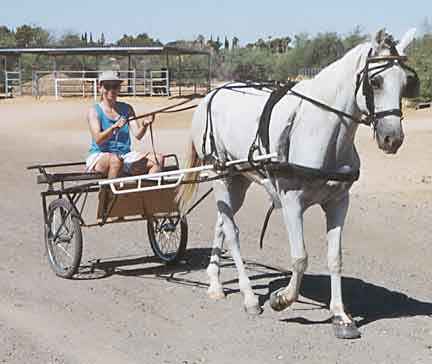
Yvonne and Inty, June 10, 2000
Back in action! Note Swiss Horse Boots.
Week of 6/12: She is beginning to display a pattern of appearing very sore and uncomfortable when I pull her out of the paddock, then after putting the boots on and walking for a minute, she is quite good. It’s such a drastic change. I begin to wonder how badly the heat is affecting her progress, as she is spending so much time standing around in the shade all day long. I continue to hand-walk her all week, and drive her on the weekend, when again she is really very good.
Week of 6/19: Begin to sense something weird is going on with her left foot again. First James trims, and discovers, where only 2 weeks ago he was hitting blood, he could now remove 1/4 inch of sole from the concavity around the frog. There is no way she could have grown that much sole that fast. We suddenly realize the hoof is looking very odd, also. There is more slipper appearing on the front of the toe. The sole of the hoof is bulging out towards the toe area. We finally realize that the small connection she had at the toe is gone and she has rotated a bit more. We decide to increase the focus on getting moisture into that hoof --the other three hooves, even the right front, are doing fine. The left one is hard as a rock, reflecting the problems going on inside it. After soaking overnight, I add water back to the boots and soak for a few minutes, then remove the boot, paint on some Hoof Balm, and quickly put the Swiss boots on to walk. That way she is walking with her feet moist, and hopefully won?t tear the laminae as much. We need stronger hoof to grow in! (24 hour a day hand-walking would help) She is walking and driving very well, even when she acts so sore before we start out.
Week of 6/26: I receive the bottle of Hoof Marvel, and begin to use this on her, also. After a few days of this, her hooves are becoming more pliable, which is great. James keeps working on her left hoof and it is really shaping up. He continues to take her heels way down, even lower than he thought he could go. She responds very well to this. Mid-week, an abscess breaks open on her left front toe again. The next day, she is walking better than ever.
Despite the cycle of constant trimming and continued soreness, I feel that we are just on the edge of a major breakthrough in her healing. It has now been 9 months since we first began the Strasser trim. Despite the significant delays in healing caused by her coronary grooving, we are making good progress. This method takes time, there is no way around it.
James buys a bucket of Farrier's Formula for Inty. I know Sabine doesn't care for it, but we figure it was worth a try to see if it helps the hoof growth at all. We are probably just wasting our money...
Week of 7/3/00: After walking pretty well last week, she begins to regress a bit. By the end of the week, she is definitely more sore, and the left toe is mushy.
Week of 7/10/00: Inty goes into a pre-abscess phase. She becomes extremely sore and lame, favoring the left front foot constantly. Her entire left leg begins to swell. Now the longer I try to walk her, the worse she gets! With the heat and her extreme pain, it is hard to keep up with the walking, though I try. Finally at the end of the week (seemed like it took longer!) the abscess bursts and drains at the top of the left front coronary band. Unfortunately, this does not provide a lot of relief, so there must be more abscesses in there!
Week of 7/17/00: The abscess continues to drain along the front and inside of the front left coronary band. After a night of soaking it looks so similar to the grooving (all puffed up) that it gives me flashbacks! But it is fine, the swelling goes back down after it dries out. Her leg swelling slowly gets better each day, and she does walk a tiny bit better each day. It is just not the drastic improvement I was hoping for.
Because she is losing condition again, I start her on an energy supplement from ABC (where I got her free choice minerals), to see if that can help at all.
Week of 7/24/00: She continues about the same, but just a little better each day. She does seem perkier by the end of the week, and is up and moving around more in the paddock.
Week of 7/31/00: The abscesses appear to have finished draining. She continues on about the same.
Week of 8/7/00: Finally a breakthrough--she gets better. She begins to really perk up, and is walking sound on soft ground or in the Swiss Boots. She still starts out very sore, and I worry, but then after a few minutes of exercise, she is great. The longer I walk her, the better she gets! Hopefully we are over that last, final hill!
By mid-week she is walking so well that I put the bareback pad on her and ride her again, for the first time in a couple months now! This really makes our day. She seems happy about it, and walks out really well. Wow, I can't believe it.
This certainly isn’t the end of the story--rather, it is just the beginning. We may have far to go to total recovery, but we really have come a long way. What was one of the worst experiences of my life has become life-changing in such a positive way. I may have never discovered natural hoofcare and the deeply imbued philosophies behind it, if it were not for the illness of my beloved mare.
Advice to Other Horseowners with Laminitic Horses
Unfortunately, this method is often turned to as a last resort, when traditional methods have failed. By this point, such severe damage has been done to the hoof capsule that recovery will never be painless or easy.
This method is not for the faint of heart! You must be prepared for a high level of commitment. You cannot combine the Strasser method with other approaches. Strict adherence to the principles is mandatory! If you are not thoroughly versed in these principles, then you must educate yourself.
The horse's shoes must be removed immediately, of course. He must be taken off all drugs. He must be put into a natural boarding situation of 24 hour/7 day turnout in a herd of other horses. You must be prepared to spend the necessary time every day to soak all 4 feet in water, and any abscessing hooves in vinegar water. The horse must be hand walked, and later ridden, as much as you are able to do, up to 15 miles a day. If the horse is unwilling to walk, he must be forced to walk, with the help of a whip, if need be. This is not cruel, this is rehabilitation.
You must be willing to do what is necessary to become educated in the very specialized trim needed for the foundered horse. The trim will be crucial to your horse's ultimate recovery, and you will most likely need hands-on training or expert help to do the trim correctly
Most importantly, you must be willing to endure the healing process. Inevitably, your horse will abscess as soon as your trim is correct (and may continue to abscess for up to a couple years!) This is not the point at which to give up! This is a sign that the healing has begun. Do not feel sorry for the horse and give him drugs or allow him to lay down for long periods of time! You must be as brave as your horse will be. The pain will pass, and will soon be forgotten. If this method is strictly adhered to, you horse will make a complete and total recovery. No other method can provide such incredible results.
What could have been just another tragic tale of laminitis has instead become a heroic journey for me and my horse. What I have learned on this journey will affect the rest of my life, and the lives of all my future horses. My horses will never live in a stall, they will never wear shoes on their feet, and they will never have to suffer the kind of pain that Inty has endured.
As of August, 2000, Inty is sound on all her feet except the LF, which continues to be sore off and on.
Eventually, though, Inty was put down.
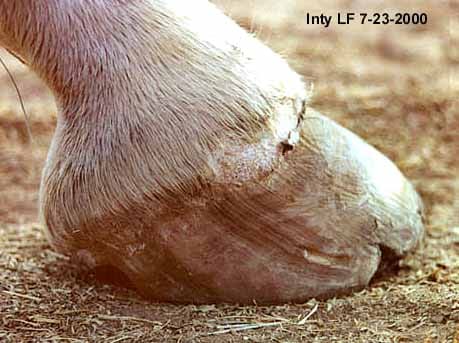
Inty, LF, July 23, 2000--more progress!
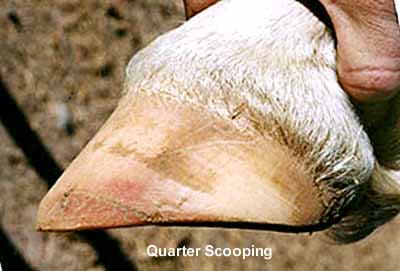
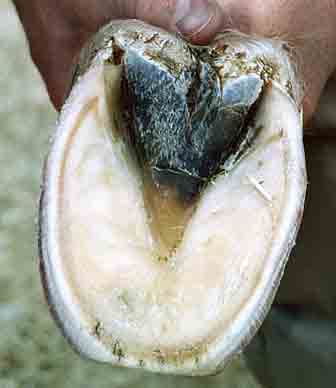
Inty, LH, which had also been foundered, August, 2000
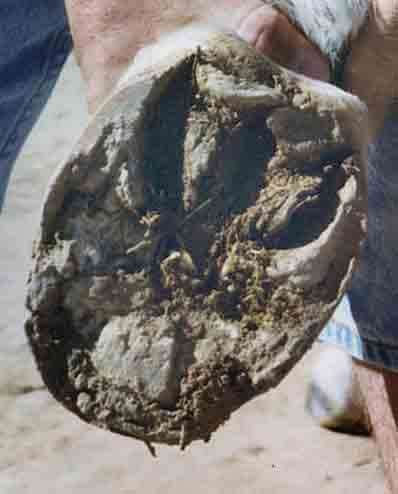
Inty, LH sole, "Before" (summer, '99)--MAJOR PROGRESS!
Back to home page--Table of Contents
Article in sections with "thumbnail" photos for fastest downloads:
1 9 17
2 10 18
3 11 19
4 12 20
5 13 21
6 14 22
7 15 23
8 16 24
NAVICULAR
Article in sections with full-sized photos for print-outs:
1 9 17
2 10 18
3 11 19
4 12 20
5 13 21
6 14 22
7 15 23
8 16 24
NAVICULAR
To Strasser case studies--thumbnail photos for faster downloads
To Strasser case studies--large photos
Please sign my guest book! Photos of my pets My farm
Share Barefoot success stories on this page
Buy or sell used HORSE BOOTS Natural board Barn Listings
Click here to subscribe to naturalhorsetrim
(I moderate this listserv to weed out "fluff.")
Send Email to Gretchen Fathauer, or call (740) 674-4492
Copyright by Gretchen Fathauer, 2015. All rights reserved.